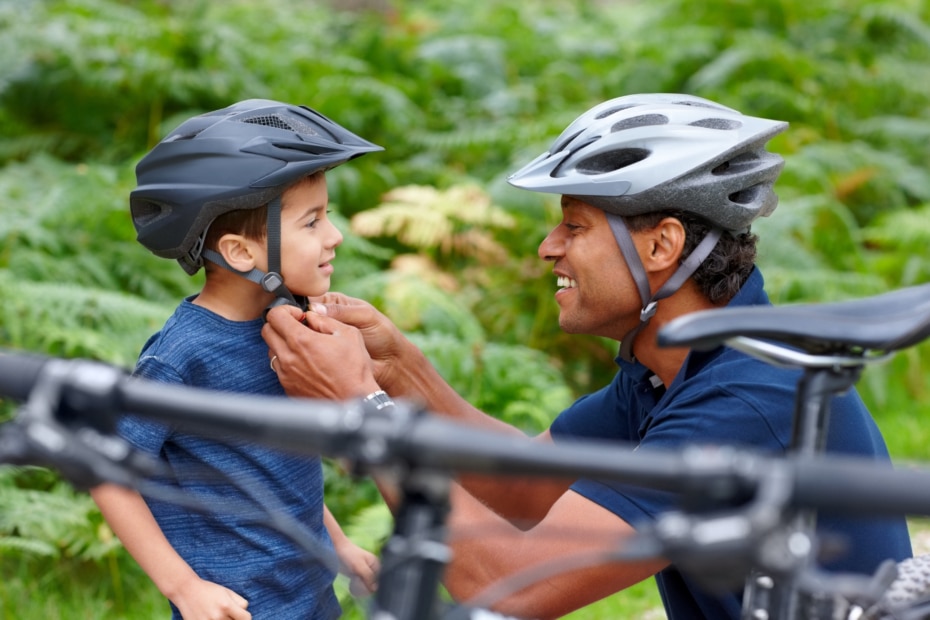Call Us At 519.672.5666
Insights & Articles
Helmets: Not One Size Fits All…

As the weather improves, more and more people of all ages will be pursuing outdoor activities. School closures and lockdowns are making everyone restless, and everyone is doing what they can to stave off boredom. Cycling, skateboarding and other activities are some of the ways we can get exercise and enjoy the beautiful weather. Whether you prefer to bicycle, tricycle, skateboard, operate a scooter or go in-line skating, here is some information regarding helmets, for both children and adults alike.
Keeping Safety Top of Mind
“In Canada, injury is the leading cause of death for not only children, but for all Canadians between the ages of one and 44.”[i]
The Canadian Paediatric Society recommends helmet use in order to reduce the risk of head injury.[ii] This would include a variety of activities that carry risk, such as skateboarding or in-line skating.
For cycling, it is the law in Ontario that every cyclist under the age of 18 must wear an approved helmet. In bicycle mishaps, the forehead is usually the first part of the body to hit the ground after a fall, which makes wearing a bicycle helmet essential for safety.[iii] In fact, a 2012 study in the Canadian Medical Association Journal found that cyclists who do not wear a helmet are three times more likely to suffer fatal brain trauma than those who wear protective headgear.[iv]
Not only will a helmet help reduce the risk of catastrophic head injuries, it can also increase the visibility of a cyclist or skateboarder on the road. Wearing a highly visible helmet can create contrast and command drivers’ attention. This is especially relevant if you enjoy cycling at night – often bicycle helmets feature reflective pieces to ensure the visibility of riders.
Regardless of your age, protect your head and wear a helmet.
The Right Helmet
It is imperative to have the right helmet. Bike helmets can be used for in-line skating and scooter riding; however, skateboarding has its own dedicated type of helmet. Skateboard helmets cover more of the back of the head and are designed to protect against more than one crash. This is because falls are common in skateboarding. The materials used are designed to withstand multiple impacts on the same spot.[v]
Helmets are made not only for the type of activity but also for different ages. There are special helmets for toddlers, under the age of 5, that provide more protection at the back of the head. Since some children grow faster than others, it is important to monitor the fit of your child’s helmet.
Helmets come with extra padding which can be added to the front or back in order to ensure proper fit. Follow the instructions provided on yours or your child’s specific helmet.
Replacing the Helmet
Bicycle helmets should be replaced after a crash where the cyclist has hit his or her head, as these helmets are only designed to protect against one crash. Head injuries rank among the most severe injuries in bicyclists, representing 20-40% of all bicycling injuries encountered in Canadian emergency departments.[vi]
When a crash involves hitting the head, the foam inside the helmet will compress, which reduces its ability to provide protection should another crash occur. Even if the helmet does not look damaged, it should be replaced.
It is never a good idea to use a second-hand helmet, because you do not know if the helmet has been in a crash. The plastic on older helmets also starts to dry out and will become brittle with age. Helmets should be replaced every 5 years, for this reason.
As noted above, skateboard helmets are designed to withstand multiple impacts on the same spot, as falling is common in skateboarding. If you or your children are riding a skateboard, everyone should be wearing the appropriate skateboarding helmet.
Set the Tone
Be a role model. Prioritize your own safety by wearing a helmet, and acknowledge the influence you have over others. Children often follow the examples set by their parents and their peers. By taking the first step to set the tone and wear a helmet, you can help reduce the risk of head injury for all those around you.
Ensure that you wear a helmet when you are out exploring local trails on your bike or showing off moves on your skateboard.
Remember, while helmets can help mitigate injury in the event of a collision or fall, the best injury prevention is to manoeuver your skateboard, inline skates and bicycles safely to prevent a collision or fall from happening in the first place.[vii] Keep your speed under control; keep your eyes on the road; be aware of your surroundings; and ensure others can see you, and ensure a helmet is part of your safety equation.
Advocating for Your Legal Rights
Please contact a personal injury lawyer today for a free initial consultation by email or by phone at (519) 672-5666. In many cases, your legal fees are deferred until a settlement is reached. We welcome referrals from other lawyers.
This article was written by member of the Personal Injury Team at McKenzie Lake. If you require assistance with a personal injury matter or wish to speak to a personal injury lawyer at McKenzie Lake Lawyers LLP, please call (519) 672-5666.
[i] Yanchar, N et al “Child and Youth Injury Prevention: A Public Health Approach” Paediatr Child Health 17(9): 511 https://www.cps.ca/en/documents/position/child-and-youth-injury-prevention
[ii] Hagel, B., Yanchar, N. “Bicycle helmet use in Canada: The need for legislation to reduce the risk of head injury” Canadian Paediatric Society Paediatr Child Health 2013;18(9):475-80 https://www.cps.ca/documents/position/bike-helmets-to-reduce-risk-of-head-injury#ref1
[iii] https://canadasafetycouncil.org/dont-lose-your-head-over-helmet-safety/ June 11, 2014
[iv] Ibid
[v] Ibid
[vi] Supra note ii
[vii] Supra note iii

